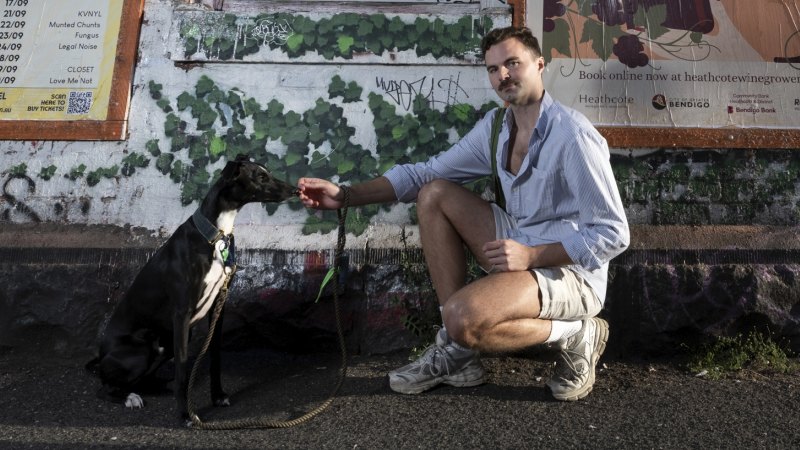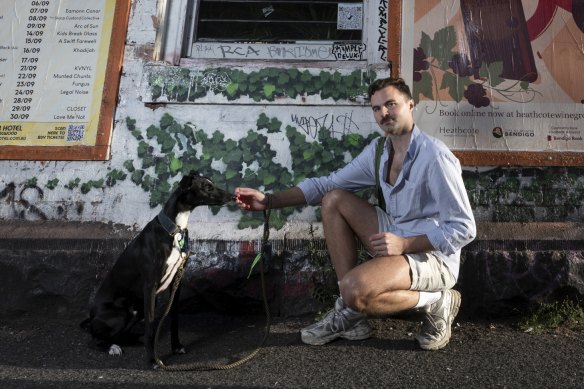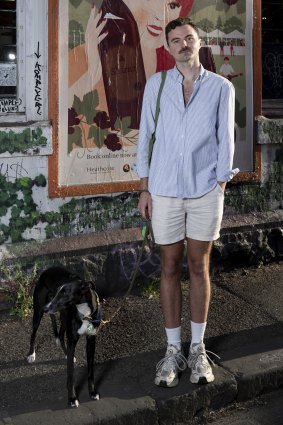
Road-safety experts push for 30km/h speed limit to save lives
September 22, 2023Save articles for later
Add articles to your saved list and come back to them any time.
Victoria’s key road-safety agencies have signalled support for cutting speeds to 30km/h in some busy areas in a push to save lives and prevent serious injuries.
The Victorian Government Road Safety Partners – which consists of the Transport Accident Commission (TAC), Victoria Police and the transport, justice and health departments – have told a parliamentary inquiry that setting and enforcing lower speeds is critical to making the state safer for pedestrians and cyclists.
Harrison Watt, pictured with his two-year-old whippet Tippy, says Fitzroy is a safer place to walk and cycle since speed limits were reduced.Credit: Penny Stephens
Twenty-eight pedestrians and eight cyclists have been killed on Victorian roads so far this year, out of a total of 207 road deaths, according to the TAC.
A growing number of jurisdictions globally are following a World Health Organisation recommendation to set speed limits at 30km/h in areas where people and vehicles mix.
NSW added 30km/h to its speed limit guidelines in July, so it is now an option for busy pedestrian areas with low traffic.
In Victoria, however, 30km/h is not a standard speed zone and can only be implemented in “trials” – such as the one underway in parts of Fitzroy and Collingwood – and 50km/h remains the default urban speed limit.
The Road Safety Partners said in their submission that “successive studies” had shown 30km/h was the “maximum impact speed for a healthy adult before death or very serious injury becomes increasingly likely”.
“A pedestrian or cyclist struck at 50km/h experiences a 90 per cent chance of being killed in the impact compared to a 10 per cent chance of being killed if struck at 30km/h,” the submission says.
At 40km/h – which is widely used in busy activity areas and around schools – there is still a 60 per cent likelihood a person hit at that speed will be killed, the research shows.
While not calling directly for Victoria to reduce speed limits, the government agency submission said travel speeds were “the single most important factor in reducing the incidence and severity of injuries to VRUs [vulnerable road users].”
“The setting and enforcement of safe system speeds, to reduce crashes with VRUs or reduce impact speeds to survivable levels, is critical to reducing trauma among VRUs,” it said.
The submission references government data showing that every year before the COVID-19 pandemic, on average, two pedestrians were killed in crashes in 40km/h zones, six died in 50km/h zones and 15 died in 60km/h zones.
TAC received insurance claims from 3920 pedestrians and cyclists injured in 40km/h zones in the 10 years to 2017, and 11,850 from crashes in 50km/h zones.
TAC head of road safety Samantha Cockfield told the inquiry during a public hearing in August that 30km/h zones had been adopted in other parts of the world “with some really quite great success”.
“Speed really is the underlying issue that we have … with our vulnerable road users and what we need to really start addressing,” Cockfield said.
The City of Yarra has implemented 30km/h zones across parts of Fitzroy and Collingwood– between Alexandra Parade, and Nicholson, Hoddle and Smith streets – in a two-year trial approved by the state government. It has proposed expanding the trial further south to Victoria Parade. A trial also started this year in part of Mildura in the state’s north-west.
Before the 30km/h trial, motorists “were just sort of fanging around the back corners,” says Harrison Watt.Credit: Penny Stephens
Fitzroy resident Harrison Watt said he felt his local streets had become safer for walking and cycling since the 30km/h trial started in 2018.
“Prior to the 30km/h trial, [motorists] were just sort of fanging around the back corners. We have a dog and we’re out walking a lot of the time so it’d be pretty unsafe,” Watt said.
“When you’re driving and the speed is a lot lower, you’re going to be able to pay more attention to what your surroundings are – it just feels so much safer.”
The lower house inquiry is examining the impact of how the pandemic influenced vulnerable road user safety. Local councils – which control around 85 per cent of the state’s roads – have told the inquiry they face a long and difficult process getting state government approval to reduce their road speeds, even to 40km/h.
Merri-bek Council city infrastructure director Anita Curnow said the local government wanted to implement 30km/h zones, but the fact it was not a standard limit was a key barrier. Busy activity centres could also only be considered for a speed reduction from 60km/h or 50km/h to 40km/h if they continued for longer than 400 metres, she said.
City of Kingston principal transport engineer Alex Reid told the inquiry that most councils wanted to reduce speeds on their own roads, but getting government approval could take up to a year and was a “very onerous” process, which was a “disincentive to want to make some of those changes”.
The Australasian College of Road Safety called for 30km/h limits in areas with high pedestrian and cyclist traffic in its submission, along with better infrastructure for cyclists, while noting the growing number of large vehicles like SUVs on the roads.
“These larger vehicles are overrepresented in pedestrian and cyclist fatalities, with children up to eight times more likely to die if hit by an SUV than by a passenger vehicle,” the college said.
The Road Safety Partners also said police enforcement programs to deter unsafe behaviour were critical to saving lives, and that the perception of reduced police presence during the pandemic may have contributed to an increase in dangerous behaviour.
Minister for Roads and Road Safety Melissa Horne said the increase in road deaths in Victoria this year was reflected nationally and “a complex challenge”.
“We’ll always consider road safety initiatives to keep Victorians safe – but driving down road trauma takes all of us doing the right thing every time we hit the road,” Horne said.
Get the day’s breaking news, entertainment ideas and a long read to enjoy. Sign up to receive our Evening Edition newsletter.
Most Viewed in National
From our partners
Source: Read Full Article




